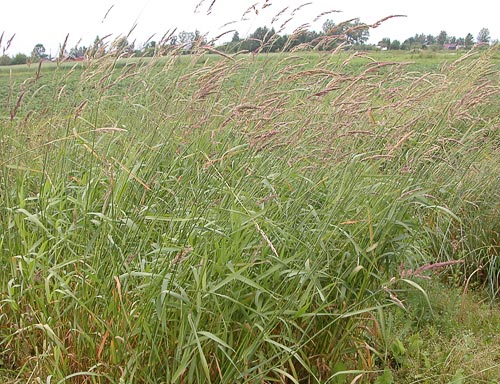Crops
Phalaroides arundinacea (L.) Rauschert. - Reed canary grass.
Taxonomic position.
Family Poaceae Barnhart., genus Phalaroides Wolf.Synonyms.
Phalaris arundinacea L., Typhoides arundinacea (L.) Moench, Baldingera arundinacea (L.) Dum., Digraphis arundinacea (L.) Trin.Biology and morphology.
2n = 14, 28, 35, 42, 56. Perennial plant, very robust, hairless, rhizomatous. Tends to grow in clumps or tussocks, but spreads through short, scaly rhizomes, forming a very dense sod. Stems erect, up to 180-250 cm tall. Leaf blade rolled when young, wide (8-16 mm), long (up to 25-28 cm), finely striate, almost smooth, pale green. Ligule long (almost 5 mm), oval-obtuse. No auricles. Panicle-like inflorescence, elongated (10-20 cm), spreading at flowering then contracted, whitish green to purple. Spikelets contain single flowers. The brown to grey-black seeds are obovate, smooth and waxy. The seeds readily shatter at maturity, shattering from the top of the panicle downward. Blossoms in June; seed maturity during July-August. The weight of 1000 seeds is 0.80 to 1.0 g (small seeds). Cross-pollinated by wind.Distribution.
Has been cultivated since the 19th century. Cultivated on relatively small plots in forest areas in 34 regions and republics of former USSR. Five breeding cultivars have government approval for use in cultivation.Ecology.
Mesophyte. Restricted to wet and boggy soils. Withstands a large range of nutrient availability but favors rich soils. Withstands a large range of soil pH as well; thrives in both acidic and basic soils. Perfers peat soils. Frequently found in clay soils. Less abundant in soils of rough texture. Not resistant to drought. This grass is able to withstand stagnant water for up to two months and tolerates waterlogged soils. Resistant to late spring frosts (-4 to -6°C) and to early autumn frosts (-5 to -6°C).Utilization and economic value.
Reed canary grass is exceptionally high-yielding for hay. When harvested in the early heading stage, its nutritive value is comparable to that of other forage grasses. The tall, coarse nature of this grass makes it acceptable as silage. Reed canary grass is very useful for pasture. It starts to grow early in the spring, showing a good distribution of growth throughout the season. The dense sod of reed canary grass makes it useful on eroding waterways, shorelines and ditch banks. Forage mass productivity ranges from 16-24 MT/ha; hay productivity ranges from 3.5-5.0 MT/ha; first-year and forage mass productivity ranges from 40-60 MT/ha; hay productivity ranges from 7.0-13.0 MT/ha in subsequent years. Seed productivity is 50-500 kg/ha.Literature cited:
Catalog of state-permitted cultivars of agricultural crops. 1969. - M.: Kolos, 489 pp. (in Russian).Catalog of state-permitted cultivars of agricultural crops. 1971. - M.: Kolos, 488 pp. (in Russian).
Catalog of state-permitted cultivars of agricultural crops. 1974. - M.: Kolos, 480 pp. (in Russian).
Catalog of state-permitted cultivars of agricultural crops. 1985. - M.: Kolos, Vol 3. - 489 pp. (in Russian).
Catalog of agricultural crop cultivars permitted in Byelorussia. 1985. - Minsk: Uradjai, 176 pp. (in Russian).
Golovkin B.N. 1988. Cultigenic plant area. - M.: Nauka, 184 pp. (in Russian).
Kashtanov A.N., ed. 1983. The Natural-agricultural regions and utilization of soil resources of the USSR. - M.: Kolos, 336 pp. (in Russian).
Medvedev P.F., Smetannikova A.I. 1981. The forage crops of the European part of the USSR. - L.: Kolos, 336 pp. (in Russian).
Shashko D.N. 1967. Agroclimatic region of the USSR. - M.: Kolos, 335 pp. (in Russian).
Shashko D.N. 1985. Agroclimatic resources of the USSR. - M.: Kolos, 248 pp. (in Russian).
Soil resources of the USSR (Agricultural regions of areas and republics of USSR). 1990. - M.: - Vol 1. - 260 pp. (in Russian).
State register of Ukrainian plant cultivars. 1992. - Kiev: Urojai, 199 pp. (in Russian).
State register of breeding achievements permitted for utilization. Plant cultivars. 1994. - M.: - 218 pp. (in Russian).
State register of breeding achievements permitted for utilization. Plant cultivars. 1996. - M.: - 171 pp. (in Russian).
State register of breeding achievements permitted for utilization. Plant cultivars. 1999. - M.: - 192 pp. (in Russian).
State register of breeding achievements permitted for utilization. Plant cultivars. 2000. - M.: - 232 pp. (in Russian).
State register of breeding achievements permitted for utilization. Plant cultivars. 2001. - M.: - 252 pp. (in Russian).
State register of breeding achievements permitted for utilization. Plant cultivars. 2003. - M.: - 236 pp. (in Russian).
The register of plant cultivars in Ukraine. 1996. - Kiev: Urojai, 259 pp. (in Russian).


